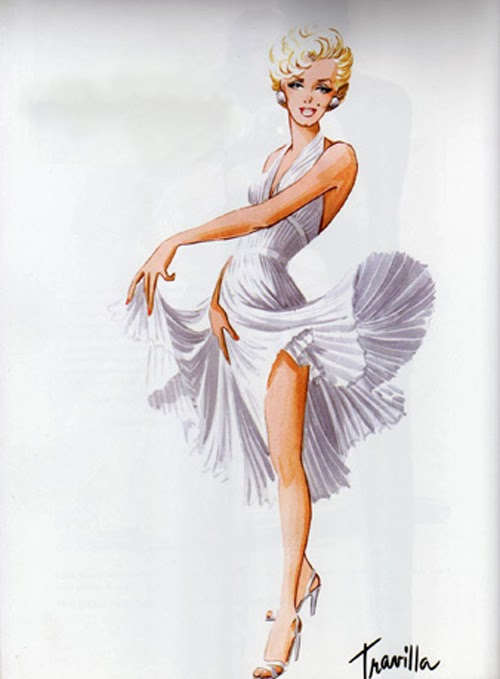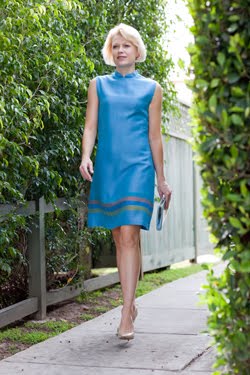Though perhaps best known for his work in the 1950s, his career stretched from film in the 1940s to television of the 1980s where he helped shape the style of the decade in shows such as Dallas and Knots Landing. As a result, there is a nearly endless list of celebrities who absolutely adored him. Barbara Stanwyck, Lana Turner, Ava Gardner, Lauren Bacall, Loretta Young, Ann-Margret, Faye Dunaway, Debbie Reynolds, Joanne Woodward, Mitzi Gaynor, Diahann Carrol, Sharon Tate...this is only the beginning. As biographer and Travilla Foundation founder Kimberley Ashley observes, "Many celebrities of the golden era of Hollywood depended upon the Travilla touch for their career success. He touched their lives with his silver screen alchemy."
Thus, I enticed Ashley to talk even more about the costume designing legend she knows so well. Her insights are particularly poignant--she is a successful haute couture designer who very nearly apprenticed with Travilla over 20 years ago. Unfortunately, one week before they were scheduled to start working together, he suddenly and tragically passed away. She then became close with his family and longtime partner, Bill Sarris, and intimately involved herself in preserving the legacy of Travilla.
"Rather than appreciating [his films] for style’s sake, I have a deep appreciation for how he chose garments and accessories that expressed the character of the actor’s role," Ashley told me. "Billy was a master psychologist who translated that awareness into fabric, and cut, and fit in his costumes. With the flick of his wrist, and the movement of a seam, he could make someone look either fabulous or frumpy on purpose." This magician was also a kind and generous man who was beloved by all who knew him.
Here I share some insights--many surprising--into his fascinating and adventurous life.
Ok, the word "genius" endures excessive overuse in the entertainment industry, but it's near impossible to describe Travilla without it. After all, he was designing while only a child and so advanced that he was invited to take classes at the prestigious Chouinard Art Institute (now Cal Arts). Then, at only age 16, he became the youngest student to enroll at Woodbury University in Los Angeles when he began taking sketching classes in 1936. Interestingly, Woodbury is where I now teach the HISTORY OF FASHION IN FILM.
Like many costume designers since the very beginning of film, Travilla has deep connections to fashion. His relationship with Woodbury shows some of this. Because his career included both iconic costume design that influenced fashion as well as his own eponymous fashion line (label shown above and collection discussed later in this article), he was asked to return to the university two more times--first in 1950 to judge a design contest of the fashion students, and again in 1954 when the school's founder gave Travilla an honorary degree in Fashion Art.
One of Travilla's earliest sketches at age 16 (above, courtesy of WilliamTravilla.com)
and Billy at that same age when he entered Woodbury University in 1936 (courtesy of Kimberley Ashley)
Though he is most associated with 20th Century Fox and Marilyn Monroe, Travilla's one and only Oscar win for costume design came courtesy of Warner Brothers and Errol Flynn. In the early 1940s, Travilla started his time in the studio system at Warner Brothers, which would eventually include the gorgeous gowns he made for friend and fan Ann Sheridan in Nora Prentiss (1947). Though contemporary wardrobes such as this won approval with audiences, more often the Academy loves to reward period pieces instead. Travilla was nominated for an Oscar a total of four times throughout his career, but his win came for The Adventures of Don Juan (1948) in only the second year that costume design was offered as an award.
Travilla's award-winning colorful costumes for Viveca Lindfor and Errol Flynn
in The Adventures of Don Juan (1948) and Flynn's congratulatory telegram
One of the most surprising aspects to me about Travilla--a designer deeply associated with elegance--is how much he found inspiration in primitive cultures around the world. Ashley loves this dynamic within him:
Billy’s life was an interesting dichotomy. He said he loved the paradox of his childhood, which was that he split his days between changing tires at his father's tire store and studying highly refined arts. He buoyantly bounced back and forth between grease and glamour.
That habit of alternating between creating sophistication and then escaping to the rough-hewn lands of uncivilized areas stayed with him his whole life. So when he was on hiatus from his costume and fashion collection work, he would escape to Africa and South America to blend with tribal people and be anonymous. He reveled in escaping the Hollywood scene for long periods of time.
“To get new ideas I would do a hell of a lot better by going to Africa, taking a seaplane and going to visit 16 primitive tribes,” Billy once said. He felt it helped him to return refreshed and renewed to resume his creative work.
Travilla on vacation in Africa (above, courtesy of Kimberley Ashley) and
back at work at Warner Brothers
After now understanding Travilla's love for native cultures around the world, perhaps it is not a surprise to find that his favorite onscreen work was Viva Zapata (1952). Here are his own words about that experience:
[The most beautiful and] hardest work I ever did was on Viva Zapata! Elia Kazan's vibrant movie about a Mexican peasant's rise to power, starring Marlon Brando, Jean Peters, and Anthony Quinn. I found the whole cast exciting. Brando and Kazan were both marvelous to work with but, looking back, I'm most pleased at what I did for Jean.
Jean was hired to play the lady in Brando's life, I figured she would be from an upper Mexican family in a small village, so I decided to dress her five years out of date - it would have taken that long for fashions to reach where she lived.
My big problem with Jean was that she was beautifully formed in an American kind of body - long-waisted, tall, with a great healthy stride in her walk. So I took the dummy I had of Linda Darnell's body and I made a cover of that, and padded it to fit on top of Jean's body to give her the Mexican body with higher hips.
But how could I get rid of her American walk? That's when I hit upon the idea of asking Jean if I could change her shoe size. She agreed and I made her half-button shoes that were a half-size too small and uncomfortable - and she immediately lost that American walk and became the little lady of the village.
There is a time when you can be Pygmalion as a designer for movies because then you are not only doing the clothes but developing the character they are playing. It can be thrilling to create one person into somebody else.
[To give the costumes a peasant-look] I was out in the streets beating the clothes, wearing them down, greasing them down, making body pads—giving an American girl a Mexican look. It’s really more the thought that goes into a costume than just the shape of a collar. I just knew that people appreciated that. But [for all that effort] I wasn’t nominated. I couldn’t believe it. Sometimes if you’re too good, it doesn’t show. And no one realized how much work went into those clothes.
Jean Peters and Marlon Brando in Travilla in Viva Zapata (1952, above)
and friends Marilyn Monroe and Travilla out having fun in LA around that same time
Those who follow GlamAmor know there are several great costume designer-star partnerships in film history. Adrian and Joan Crawford. Travis Banton and Marlene Dietrich. Helen Rose and Elizabeth Taylor. Of course the relationship between Travilla and Marilyn Monroe was equally legendary and, like the others, was built on a foundation of deep trust. The two were friends before she became a superstar, so Marilyn knew he loved her for the person she really was, not the one whose image he helped to create onscreen. Billy once said:
Designing for Marilyn was a joy because she was so beautiful and because she needed me—she needed the protection of what I could do for her. She wouldn't go to a gallery sitting without me. The studio would have to bring me in for the day, and I'd take a piece of biased satin, wrap it over her naked body, and they would shoot her. There were no more clothes left in wardrobe to put on her for all the photographs needed by the world. I was almost always disappointed when I saw her on the screen, because she was never as beautiful as she was in person.
But Travilla felt differently and was far more firm with her, urging her toward a more elegant look. If you really think about his costumes for Marilyn, you suddenly realize that though they were certainly sensual, they were never too revealing. As an example, take a peek at his iconic pink column gown for her in Gentlemen Prefer Blondes (below). Travilla's greatest belief was that a woman should not reveal too much of her body. "That is why he loved 'illusion' in his garments," Ashley says, such as "lace insets that were completely covered with skin-toned fabric underneath. They didn’t reveal--they hinted and suggested. Billy believed in mystery."
From sketch to film for Marilyn in 1953's Gentlemen Prefer Blondes
Travilla's influence today includes Natalie Portman in Lanvin (below)
on the red carpet at the 2012 Golden Globes
One of the things I discuss again and again in classes, presentations, and now my webinar series on the HISTORY OF FASHION IN FILM is how many costume designers have a deep connection to fashion. Most from the Golden Age of Hollywood either began and/or ended their careers in the industry. Because Travilla believed in bringing elegance to every woman, he started his own fashion line in 1950--The Travilla Collection--that sold in Saks, Neiman Marcus, and other fine stores until 2002.
His beliefs about beauty extended well beyond the design itself. Ashley agreed, "His strongest conviction was that women should value themselves. He felt a person’s sense of self-esteem was vital to how others see you. He felt confidence was the most important accessory for any woman to carry with her."
His beliefs about beauty extended well beyond the design itself. Ashley agreed, "His strongest conviction was that women should value themselves. He felt a person’s sense of self-esteem was vital to how others see you. He felt confidence was the most important accessory for any woman to carry with her."
After that, he felt a woman should not be ashamed of her body. “I believe in curves” was a statement he said often and he clearly celebrated curves in his muse Marilyn. As you can see below, his fashions would work for a variety of figures and are timeless in their design.
7. Travilla now has a foundation in his name
As most know, the mission of GlamAmor is the preservation of the HISTORY OF FASHION IN FILM, so I was thrilled to find that Travilla now has a steward of his legacy. As founder of the new Ashley-Travilla Foundation, Kimberley Ashley stridently believes that "Travilla’s legacy, told accurately, should be available for students and other fans to learn from for decades to come. Some things should be owned by the world, not an individual. A foundation assures that his legacy will live on."
One of the ways she is doing her first fundraising is with a glorious coffee-table book offered through a Kickstarter campaign--The Legendary Travilla Style. Supporters will get access to early editions of the book, which is filled with exclusive photos from Ashley's extensive collection and insider stories galore from Travilla's star clients and friends. There are also incredible incentive gifts, such as a bathrobe based off of Travilla's pattern for Marilyn in The Seven Year Itch.
As most know, the mission of GlamAmor is the preservation of the HISTORY OF FASHION IN FILM, so I was thrilled to find that Travilla now has a steward of his legacy. As founder of the new Ashley-Travilla Foundation, Kimberley Ashley stridently believes that "Travilla’s legacy, told accurately, should be available for students and other fans to learn from for decades to come. Some things should be owned by the world, not an individual. A foundation assures that his legacy will live on."
One of the ways she is doing her first fundraising is with a glorious coffee-table book offered through a Kickstarter campaign--The Legendary Travilla Style. Supporters will get access to early editions of the book, which is filled with exclusive photos from Ashley's extensive collection and insider stories galore from Travilla's star clients and friends. There are also incredible incentive gifts, such as a bathrobe based off of Travilla's pattern for Marilyn in The Seven Year Itch.
Kimberley Ashley on Travilla's legacy:
"My work is to ensure that HIS work is around for future generations."
Ashley understands something even deeper, which is that we are talking about the preservation of timeless and highly influential design. This is no different than the importance that people put on fashion archives. "Imagine what a travesty it would be if a torch was set to the Chanel archives in Paris. We would lose all that beauty and enjoyment and instruction Coco’s career left for us." Likewise, this is how one should view the contributions of the great costume designers from Old Hollywood. It is especially true because of the intersection and ongoing influence of costume design on fashion. "It is vital to the awareness of future generations that they have an understanding of the roots of this Golden era," she states. "Every one of us stands upon the shoulders of all who have gone before."
The Seven Year Itch "subway" dress--the most recognized, valuable, and influential costume design in history--
and Taylor Swift proving the point in designer Rafael Cemmano







































































































10 comments:
What a great article! So glad you shared the info and images. He's really not well known at all now...so, it's great to hear the fascinating backstory!
Wonderful and so beautifully crafted! Thanks, my dear friend! Kay
Thanks Kimberly for sharing Billy Travilla's wonderful heritage. He was such a great designer for Marilyn and so many other stars of screen and television. It's been a mixed blessing for me to have his legacy go to auction (several auctions over the years). I've been able to get some of his sketches but I put my priority on another auction this time around and had to forego the last of his best work. His works did go however. And so while it wasn't destroyed like many other designers' work it still doesn't reside in an archive or institution. It seems like we take one step forward and one step back in preserving costume design history.
Thank you, Kay! It's truly bizarre to me that Travilla is considered a lesser known costume designer when E-V-E-R-Y-O-N-E knows his designs! lol I was thrilled to be able to talk with Ms. Ashley and find the opportunity to share Travilla's story.
Thank you, Christian! You know I feel just as you do about the auctions. I was there at the most recent one at Julien's and it's always devastating to me. As I half joke with friends, I wish the auction houses had an approval process that any buyer has to list how they plan to store any bought items, their intention behind buying it, etc. It's a dream of my own to have some sort of foundation to be able to save the best of the best because I completely agree with you--"it seems like we take one step forward and one step back in preserving costume design history."
I am one who knew nothing about Travilla's work, even though his designs are SO FAMOUS.
Thanks for sharing all this info. Here's hoping the Kickstarter campaign is a success. The book looks like it has some fascinating photographs.
You know, I never paid that much attention to costumes/wardrobe before I started reading your blog. I either liked a costume, or didn't. But this post is a great example of the education you provide – I had no idea Travilla would have gone to all the effort to make Jean Peters seem less "American". Brilliant!
Now if I'm ever in a conversation about movie fashion, I pass along some of your info. It makes me look like such a smarty pants!
Hello! I purchased 7 of the dresses from the Julien's auction and I am honored to have them. I own a vintage clothing boutique in Nashville and I plan on first showcasing the 7 pieces in a fashion event during Nashville Fashion Week in April 2014. Know that these pieces are very important to me and educating the public and even those in the fashion industry about Travilla's incredible talent is of the utmost priority!
God bless,
Krystle Ramos
Pura Vida Vintage
Nashville, TN
Thanks Silver Screenings! I'm delighted to know that you're enjoying the information while being educated at the same time. And happy to know that GlamAmor is helping you be a "smarty pants" (too cute). Yes, Travilla was really something--so many of these costume designers are, so I love being able to share their stories and work with you all. Thanks again!
Hi Krystle! Thanks for your comments and for reaching out. I am THRILLED, absolutely THRILLED, to know that those dresses have found a home with someone who truly appreciates them. I know Christian and Kay (who commented here as well) do, too. If I can ever be of help to you, please don't hesitate to contact me: Kimberly@GlamAmor.com. I'm forever at your service. Congratulations on having those historic gowns in your collection--be good to them! :)
Thank you Kimberly! I will definitely reach out to you while planning my showcase event. I would also like to ask you about your webinars and classes. Nashville has a burgeoning fashion industry and a few good design schools that need fashion history courses, in my opinion! I have a Travilla gown in the store now (white sunburst pleat gown from the 70s) that will be on the red carpet at the premiere of Martin Scorcese's new film "The Wolf of Wall Street" next week! Time for people to see some true Hollywood glamour!
I liked the dress that Jean Peters wore in Pickup on South Street.
Post a Comment